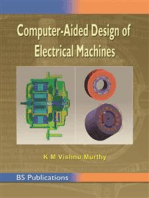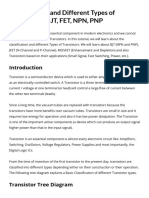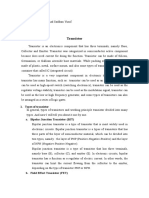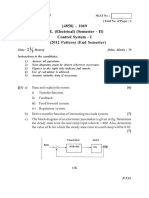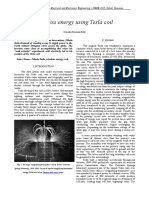Diff BTWN MOSFET and BJT
Diff BTWN MOSFET and BJT
Uploaded by
Madan R HonnalagereCopyright:
Available Formats
Diff BTWN MOSFET and BJT
Diff BTWN MOSFET and BJT
Uploaded by
Madan R HonnalagereOriginal Description:
Original Title
Copyright
Available Formats
Share this document
Did you find this document useful?
Is this content inappropriate?
Copyright:
Available Formats
Diff BTWN MOSFET and BJT
Diff BTWN MOSFET and BJT
Uploaded by
Madan R HonnalagereCopyright:
Available Formats
Difference Between BJT and
MOSFET
Categorized under Technology
BJT vs MOSFET
The transistors BJT and MOSFET are both useful for amplification and switching
applications. Yet, they have significantly different characteristics.
BJT, as in Bipolar Junction Transistor, is a semiconductor device that replaced
the vacuum tubes of the old days. The contraption is a current-controlled device
where the collector or emitter output is a function of the current in the base.
Basically, the mode of operation of a BJT transistor is driven by the current at the
base. The three terminals of a BJT transistor are called the Emitter, Collector and
Base.
A BJT is actually a piece of silicon with three regions. There are two junctions in
them where each region is named differently the P and N. There two type of
BJTs, the NPN transistor and the PNP transistor. The types differ in their charge
carriers, wherein, NPN has holes as its primary carrier, while PNP has electrons.
The operation principles of the two BJT transistors, PNP and NPN, are practically
identical; the only difference is in biasing, and the polarity of the power supply for
each type. Many prefer BJTs for low current applications, like for switching
purposes for instance, simply because theyre cheaper.
Metal Oxide Semiconductor Field-Effect Transistor, or simply MOSFET, and
sometimes MOS transistor, is a voltage-controlled device. Unlike the BJT, there is
no base current present. However, theres a field produced by a voltage on the
gate. This allows a flow of current between the source and the drain. This current
flow may be pinched-off, or opened, by the voltage on the gate.
In this transistor, a voltage on an oxide-insulated gate electrode can generate a
channel for conduction between the other contacts the source and drain.
Whats great about MOSFETs is that they handle power more efficiently.
MOSFETs, nowadays, are the most common transistor used in digital and analog
circuits, replacing the then very popular BJTs.
Summary:
1. BJT is a Bipolar Junction Transistor, while MOSFET is a Metal Oxide
Semiconductor Field-Effect Transistor.
2. A BJT has an emitter, collector and base, while a MOSFET has a gate, source
and drain.
3. BJTs are preferred for low current applications, while MOSFETs are for high
power functions.
4. In digital and analog circuits, MOSFETs are considered to be more commonly
used than BJTs these days.
5. The operation of MOSFET depends on the voltage at the oxide-insulated gate
electrode, while the operation of BJT is dependent on the current at the base
Read more: Difference Between BJT and MOSFET | Difference Between | BJT
vs MOSFET http://www.differencebetween.net/technology/difference-betweenbjt-and-mosfet/#ixzz13lNncS3V
You might also like
- BESS Proposal Description of Narada For 1MW 1.5MWhDocument14 pagesBESS Proposal Description of Narada For 1MW 1.5MWhSerg Marushko100% (4)
- Improving Reliability For Power System ProtectionDocument25 pagesImproving Reliability For Power System Protectionboopelectra100% (1)
- UniFlo Smart Gas Meters UNDocument4 pagesUniFlo Smart Gas Meters UNprasanthvvNo ratings yet
- Design of Electrical Circuits using Engineering Software ToolsFrom EverandDesign of Electrical Circuits using Engineering Software ToolsNo ratings yet
- Mosfet and BJT DiffDocument2 pagesMosfet and BJT DiffKancharana SarathchandraNo ratings yet
- Types of TransistorsDocument8 pagesTypes of TransistorszixapantherNo ratings yet
- Types of Transistors - Junction Transistors and FETsDocument16 pagesTypes of Transistors - Junction Transistors and FETsKrishanu ModakNo ratings yet
- Lecture 1 - BJTs and MOSFETsDocument12 pagesLecture 1 - BJTs and MOSFETsGhostNo ratings yet
- Transistor: What Is A Transistor and How Does It WorkDocument7 pagesTransistor: What Is A Transistor and How Does It WorkmonalisaNo ratings yet
- 3 TransistorDocument7 pages3 TransistorrameshNo ratings yet
- Mosfet: Metal Oxide Silicon Field Effect Transistor Is Abbreviated As MOSFET. It Is Merely A UnipolarDocument6 pagesMosfet: Metal Oxide Silicon Field Effect Transistor Is Abbreviated As MOSFET. It Is Merely A UnipolarJade JoseNo ratings yet
- Difference Between BJT and FETDocument2 pagesDifference Between BJT and FETkanwaljiaNo ratings yet
- UNIT II (Part 2) PDFDocument7 pagesUNIT II (Part 2) PDFZulkifl KhairoowalaNo ratings yet
- EEE 202 Lecture Note On TransistorDocument7 pagesEEE 202 Lecture Note On Transistoralexapierre08No ratings yet
- Phy210 Notes-2Document8 pagesPhy210 Notes-2Praise AribisalaNo ratings yet
- Bipolar Junction Transistor - WikipediaDocument21 pagesBipolar Junction Transistor - WikipediaFABIAN NATANAEL MURRIETA RICONo ratings yet
- ENT251 Special Diodes and FETDocument39 pagesENT251 Special Diodes and FETA76 - shashank agrawalNo ratings yet
- What Is The Difference Between BJT and FET TransistorsDocument16 pagesWhat Is The Difference Between BJT and FET TransistorsgezahegnNo ratings yet
- ECE 027 - Module 3 - Introduction of Bipolar Junction Transistors (BJT)Document58 pagesECE 027 - Module 3 - Introduction of Bipolar Junction Transistors (BJT)Miyuki NakiriNo ratings yet
- Transistor Bipolar o BJTDocument8 pagesTransistor Bipolar o BJTMijail Garay LunaNo ratings yet
- Bipolar Junction Question and Answer 2Document53 pagesBipolar Junction Question and Answer 2S MarwatNo ratings yet
- Supplementary Info: A Brief Overview of TransistorsDocument6 pagesSupplementary Info: A Brief Overview of TransistorsJoey Joe Joe Junior ShabadooNo ratings yet
- Lab Manual # 04 Power Electronics Lab: Submitted ToDocument8 pagesLab Manual # 04 Power Electronics Lab: Submitted ToEngr Abdul QadeerNo ratings yet
- Research_GariandoDocument7 pagesResearch_GariandoTristan GariandoNo ratings yet
- Differences Between BJT and FETDocument2 pagesDifferences Between BJT and FETJESSYLLNNo ratings yet
- L4 Basic-ElectronicsDocument16 pagesL4 Basic-Electronicstheo dominic silvosaNo ratings yet
- Know The Major Difference Between BJT and FETDocument11 pagesKnow The Major Difference Between BJT and FETabraham kaseyaNo ratings yet
- TransistorsDocument7 pagesTransistorsMuzakki Sathor100% (1)
- Bab 3-bjtDocument80 pagesBab 3-bjtNoor Hanisah AbdullahNo ratings yet
- Types of Transistors - Working and Their ApplicationsDocument19 pagesTypes of Transistors - Working and Their ApplicationsOsakue IdehenNo ratings yet
- Transistor EnglishDocument5 pagesTransistor EnglishArif Kusuma100% (1)
- BE 3 UnitDocument19 pagesBE 3 Unit08sunnyjaganNo ratings yet
- Transistor: Name: Gita Setyani Putri Class: LT 3E Number: 12Document8 pagesTransistor: Name: Gita Setyani Putri Class: LT 3E Number: 12Fariz Aditya PutraNo ratings yet
- TAD-Components Report - CompressedDocument12 pagesTAD-Components Report - Compressedsai.5025413No ratings yet
- Bipolar Junction TransistorDocument7 pagesBipolar Junction TransistorDA GamesNo ratings yet
- TransistorsDocument7 pagesTransistorsericoNo ratings yet
- Electronic Assignment Final 2.2Document16 pagesElectronic Assignment Final 2.2leon saifullahNo ratings yet
- Classification and Different Types of Transistors 2Document15 pagesClassification and Different Types of Transistors 2Abrham CherinetNo ratings yet
- 2M Unit 3Document3 pages2M Unit 3subikshansivasmsNo ratings yet
- BJT TransistorsDocument3 pagesBJT TransistorsJessah Marie Uctadamz IlogonNo ratings yet
- Presentation - Insulated Gate Bipolar Transistors IGBTDocument2 pagesPresentation - Insulated Gate Bipolar Transistors IGBTMimepNo ratings yet
- FET and BJTDocument7 pagesFET and BJTshaik usmanganiNo ratings yet
- Transistor - Definition, Working Principle, Types, Transistor DiagramDocument2 pagesTransistor - Definition, Working Principle, Types, Transistor Diagramsarojkumarmahto459No ratings yet
- TransistorDocument11 pagesTransistorEllaine P. De ClaroNo ratings yet
- Notes For UniversityDocument6 pagesNotes For UniversityRaja ChandruNo ratings yet
- Back To Basics Introduction To BJTs JFETs MESFETs and MOSFETsDocument28 pagesBack To Basics Introduction To BJTs JFETs MESFETs and MOSFETssonitha alvaNo ratings yet
- Bipolar Junction Transistor (BJT) - Construction, Types & Its ApplicationsDocument1 pageBipolar Junction Transistor (BJT) - Construction, Types & Its ApplicationszigijuNo ratings yet
- TRANSISTORSDocument6 pagesTRANSISTORS6qf7yt2sxcNo ratings yet
- Notes On TransistorsDocument2 pagesNotes On Transistorslitee1983No ratings yet
- Explain The Working of Fet With Neat Diagram and Relevant Characteristics. Indicate Each Region of The CharacteristicsDocument19 pagesExplain The Working of Fet With Neat Diagram and Relevant Characteristics. Indicate Each Region of The CharacteristicsS Dispiser100% (1)
- TransistorsDocument44 pagesTransistorsramil.bocaNo ratings yet
- Chapter 4-TransistorsDocument13 pagesChapter 4-TransistorsMian NomanNo ratings yet
- Seminar On Electronic Devices & Circuits: Department of Electronic & TelecommunicationDocument12 pagesSeminar On Electronic Devices & Circuits: Department of Electronic & Telecommunicationdeltawongaming007No ratings yet
- Transistor: by P.Sai SrivathsaDocument15 pagesTransistor: by P.Sai Srivathsak.saikumarNo ratings yet
- NextechDocument15 pagesNextechNEXTECH ElectroicsNo ratings yet
- LM II TransistorDocument53 pagesLM II TransistorMa. Fe TabbuNo ratings yet
- Experiment 08Document5 pagesExperiment 08joyislam6669No ratings yet
- TransistorsDocument1 pageTransistorsmarina890416No ratings yet
- Electronic Assignment Final 2.2 LNXDocument17 pagesElectronic Assignment Final 2.2 LNXleon saifullahNo ratings yet
- Bipolar Junction Transistor (BJT)Document78 pagesBipolar Junction Transistor (BJT)Dragana MladjenovicNo ratings yet
- There Are Some Advantages of Are As Given Below,: Bipolar Junction Transistor (BJT)Document4 pagesThere Are Some Advantages of Are As Given Below,: Bipolar Junction Transistor (BJT)saira safdarNo ratings yet
- Tags Are Markers To Highlight Notable Revisions in TheDocument1 pageTags Are Markers To Highlight Notable Revisions in TheMadan R HonnalagereNo ratings yet
- IETE-Journal of Research Template PDFDocument7 pagesIETE-Journal of Research Template PDFMadan R HonnalagereNo ratings yet
- Partnership Deed - AbcDocument7 pagesPartnership Deed - AbcMadan R HonnalagereNo ratings yet
- ISO Awareness: Make It EasyDocument17 pagesISO Awareness: Make It EasyMadan R HonnalagereNo ratings yet
- Operational Manual: Operational Steps Involved To Fill Institute's Registration Form For AY 2019-20Document9 pagesOperational Manual: Operational Steps Involved To Fill Institute's Registration Form For AY 2019-20Madan R HonnalagereNo ratings yet
- Certificate For True ForDocument1 pageCertificate For True ForMadan R HonnalagereNo ratings yet
- How To Write An Author Bio & Why (With Examples)Document21 pagesHow To Write An Author Bio & Why (With Examples)Madan R HonnalagereNo ratings yet
- Resume Dr. Sandeep MalikDocument1 pageResume Dr. Sandeep MalikMadan R HonnalagereNo ratings yet
- Quality Manual Tarento - V2.2Document36 pagesQuality Manual Tarento - V2.2Madan R Honnalagere100% (1)
- Certificate For Madan HR For - Check Your Awareness On PayscaleDocument1 pageCertificate For Madan HR For - Check Your Awareness On PayscaleMadan R HonnalagereNo ratings yet
- Project Plan For Implementation of The Quality Management SystemDocument4 pagesProject Plan For Implementation of The Quality Management SystemMadan R HonnalagereNo ratings yet
- ISO 9001-2015 V 2008 Correlation MatrixDocument10 pagesISO 9001-2015 V 2008 Correlation MatrixMadan R HonnalagereNo ratings yet
- Management Review: ISO 9001:2015 GuidanceDocument3 pagesManagement Review: ISO 9001:2015 GuidanceMadan R HonnalagereNo ratings yet
- Control of Management Reviews Procedure Sample PDFDocument4 pagesControl of Management Reviews Procedure Sample PDFMadan R HonnalagereNo ratings yet
- Datasheet MHDACDocument25 pagesDatasheet MHDACPhùng Ngọc TânNo ratings yet
- A Project Report On: Submitted By: Manish Gupta Manish ChauhanDocument72 pagesA Project Report On: Submitted By: Manish Gupta Manish Chauhanlove_amyNo ratings yet
- Samsung LE26A33J-LE32A33JN Chassis GJE26SE-GJE40SEDocument266 pagesSamsung LE26A33J-LE32A33JN Chassis GJE26SE-GJE40SEРемонт Компьютеров100% (1)
- Android For The BeagleBone Black - Sample ChapterDocument17 pagesAndroid For The BeagleBone Black - Sample ChapterPackt PublishingNo ratings yet
- Compressor User Manual V0.2 A5Document12 pagesCompressor User Manual V0.2 A5Mohammed TarigNo ratings yet
- Mil STD 1788aDocument67 pagesMil STD 1788aaluruvamsiNo ratings yet
- Philip FW c355Document15 pagesPhilip FW c355Julio LopezNo ratings yet
- Tpa 3116Document1 pageTpa 3116Edi KurniawanNo ratings yet
- L-19 CSS Solar PV System DesignDocument33 pagesL-19 CSS Solar PV System DesignAFNo ratings yet
- Change SCDocument9 pagesChange SCRizky JuliadiNo ratings yet
- MRFU 1800MHzDocument13 pagesMRFU 1800MHzLucasNo ratings yet
- Cpe Diary G7Document20 pagesCpe Diary G7vaishnavimachhirkeNo ratings yet
- Arum 5X 400 Warranty DetailsDocument3 pagesArum 5X 400 Warranty Detailscr89omfNo ratings yet
- Soft Robotics PDFDocument11 pagesSoft Robotics PDFAbhishek UpadhyayNo ratings yet
- Nota Padat Fizik SMK Merbau MiriDocument37 pagesNota Padat Fizik SMK Merbau MiriCikgu Faizal100% (11)
- T.E. (Electrical) (Semester - II) Control System - I: Time: Hours) (Max. Marks: 70 Instructions To The CandidatesDocument4 pagesT.E. (Electrical) (Semester - II) Control System - I: Time: Hours) (Max. Marks: 70 Instructions To The CandidatesShubham KaklijNo ratings yet
- Arjun Training ReportDocument36 pagesArjun Training ReportARYAN ANo ratings yet
- Geas FinalDocument489 pagesGeas FinalroselleNo ratings yet
- App8Document7 pagesApp8César Rodriguez BNo ratings yet
- AL400ULX Series: Power Supply/Charger Installation GuideDocument8 pagesAL400ULX Series: Power Supply/Charger Installation Guidesofia hernandezNo ratings yet
- The Design of DC Motor Driver For Solar Tracking ApplicationsDocument4 pagesThe Design of DC Motor Driver For Solar Tracking ApplicationsНеМаЊаA JovicicNo ratings yet
- PVI-10.0/12.5-TL-OUTD 10 To 12.5 KW: ABB String InvertersDocument4 pagesPVI-10.0/12.5-TL-OUTD 10 To 12.5 KW: ABB String InvertersVarazhdinecNo ratings yet
- Wireless Energy Using Tesla CoilDocument4 pagesWireless Energy Using Tesla Coilbogdan_zenithNo ratings yet
- HUAWEI Distributed Power System DatasheetDocument3 pagesHUAWEI Distributed Power System Datasheetanon_887406747No ratings yet
- DLL CSS 9Document4 pagesDLL CSS 9Edgar Ocos Nagalisac100% (2)
- Edvocycler & Megacycler: Cat. #541 and #542Document8 pagesEdvocycler & Megacycler: Cat. #541 and #542Noor SaberNo ratings yet




